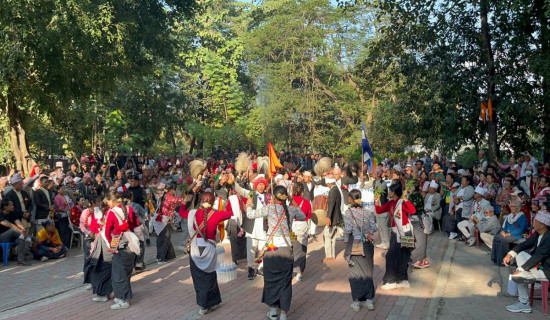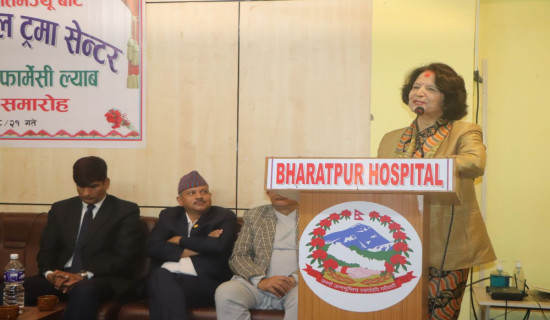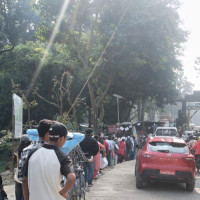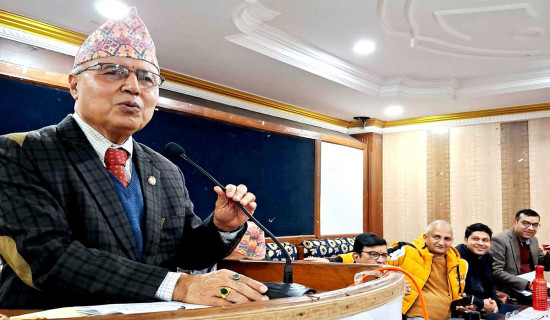- Monday, 8 December 2025
A Concept For Inclusive Economic Growth
Nepal's development planning suffers from persistent shortcomings in key areas—employment generation, local economic development, import substitution, and export promotion—primarily due to ineffective implementation. Centralised planning, inconsistent industrial policies, and inadequate inter-agency coordination contribute significantly to these failures. While numerous initiatives exist, their impact is constrained by poor execution, limited scope, and insufficient private-sector participation. Therefore, a comprehensive reform agenda is necessary, emphasising decentralisation, robust public-private partnerships, evidence-based policymaking, and inclusive implementation strategies to translate policy into tangible results and drive structural transformation.
Nepal's economic prosperity depends on the revitalisation of its local economies. This necessitates empowering local governments, strategically leveraging regional resources such as biodiversity and traditional skills, and cultivating robust local value chains. Key components include decentralised job creation, enhanced market access, and reduced import reliance. A comprehensive national programme analogous to Rajthali must institutionalise this community-driven, sustainable development approach, providing local governments with the necessary authority, resources, and support. This represents a significant policy opportunity to foster resilient and sustainable economic growth.
Rajthali: A guide to nobility
Regional Action Junction for Trade, Heritage, and Advantage Linkage Initiative (Rajthali) is a transformative concept that aims to institutionalise a locally anchored model of inclusive economic development. It bridges the gap between economic value creation and cultural heritage by promoting dignity, equity, interdependence, and local ownership. Envisioned as more than just a programme, Rajthali is a movement that empowers communities to thrive through shared values and harmony. Integrating socio-economic values, innovative advantages, and community-based development reimagines Nepal as a network of self-sustaining regions that uplift one another through cooperation and mutual respect.
With municipalities positioned as potential hubs for trade and tourism, Rajthali seeks to unlock its latent capacity by offering a comprehensive framework that brings together governments, MSMEs, artisans, and other stakeholders. It creates vibrant, multifunctional spaces with essential amenities, tourism, and economic infrastructure such as retail areas, food courts, accommodation, workshops, warehouses, information hubs, recreational centres, and cultural exhibitions. Additionally, it supports disaster resilience, tourism information, and monitoring of innovation initiatives. Through these interconnected services, Rajthali provides a unified platform to drive regional growth, preserve cultural identity, support local industry, and ensure sustainable development for residents and visitors.
Key contributions
Rajthali integrates traditional knowledge, heritage, and trade opportunities with modern business practices. Its initiatives promote sustainable growth by linking heritage-based industries with contemporary markets, creating a robust foundation for community empowerment and economic stability.
Rajthali supports local producers, artisans, and small-scale industries by providing access to business information and larger markets. This initiative connects local products and services to national and international trade networks, enabling communities to achieve better market penetration and profitability. Creating these market linkages helps local businesses scale up and become competitive, increasing income and employment opportunities.
One of the core components of Rajthali is the preservation and utilisation of local heritage, crafts, and Indigenous knowledge, skills, and resources (IKSaR). It integrates these elements into modern business models, ensuring cultural assets are preserved and economically viable. Intellectual property creation, utilisation, and protection are other key aspects. This approach helps transform traditional practices into sustainable business ventures, thus ensuring that cultural heritage becomes a source of livelihood for local communities.
Rajthali strongly emphasises capacity building and skill development at the local level. It organises training programmes, workshops, and mentorship sessions to equip local entrepreneurs, artisans, and community members with the skills to thrive in a modern business environment. Through skill enhancement, the initiative helps build a workforce capable of adapting to new technologies, improving production quality, and effectively meeting market demands.
By focusing on local industries and heritage-based entrepreneurship, Rajthali helps create job opportunities within communities. This initiative reduces the need for out-migration by providing viable economic alternatives at the regional level. Employment generation leads to better livelihoods, enhancing social stability and reducing migration's social costs.
Rajthali is committed to promoting inclusive growth by prioritising the participation of marginalised groups such as women, youth, and ethnic minorities. By providing equal opportunities and targeted support, the initiative ensures that all community members benefit from socio-economic development, thus reducing inequality and fostering a more balanced growth trajectory.
Rajthali significantly strengthens local value chains by encouraging innovation, improving product quality, and establishing connections between producers, suppliers, and markets. By enhancing local value chains, the initiative boosts productivity and marketability, ensuring local products meet domestic and international standards.
Rajthali's emphasis on sustainable practices, such as eco-friendly production methods and responsible resource use, ensures that development does not come at the cost of environmental degradation. Additionally, empowering local communities to take ownership of their economic and cultural resources helps build resilience and self-reliance, laying the groundwork for long-term socio-economic sustainability.
Rajthali enables the design, delivery, monitoring, and evaluation of local development initiatives by guiding the full cycle of intervention planning and implementation. It begins by designing interventions that tap into local strengths—such as traditional crafts, agro-biodiversity, and cultural heritage—to create economically viable and socially embedded initiatives.
It ensures effective service delivery through collaboration with municipalities, cooperatives, and private sector partners, backed by clear accountability structures. For monitoring progress, it employs community-based, real-time tracking tools and digital systems that enhance transparency and responsiveness. Finally, its impact evaluation process utilises localised indicators and inclusive frameworks to assess social, economic, and environmental outcomes, creating a continuous feedback loop for policy learning and adaptation. Additionally, it plays a catalyst role in enhancing the effectiveness of development interventions such as industrial districts and special economic zones, among others.
Decentralised future
The success of Rajthali hinges on the active participation and collaboration of multiple stakeholders. An underlying idea is public-private partnerships in which local government is pivotal in effectiveness. A separate law consists of its functional structure, governance and compliance mechanisms, policy support and strategic direction provision, risk mitigation measures, and advantage enhancement modalities. The law prioritises the local community, farmers, and MSMEs and their offerings. The governments, civil society organisations, NGOs, and international partners are instrumental in building infrastructure, transferring technology, providing operational funding, and sharing best practices. A robust governance structure is established, involving local committees and advisory boards, to ensure that the initiative aligns with the interests and needs of the community.
Rajthali promises many benefits, encompassing economic, social, and cultural dimensions. Economically, it is expected to boost the local economy by increasing MSME sales by 20–30 per cent and generating employment opportunities, with 150 direct and 400 indirect jobs. Municipal revenues are also projected to rise due to enhanced tax collection and public investment opportunities.
In tourism and cultural preservation, Rajthali is anticipated to increase tourist arrivals by 15–20 per cent, generating an annual income of Rs. 10–15 million. Showcasing local art and heritage fosters cultural conservation and strengthens community identity. Socially, the initiative empowers marginalised groups by creating opportunities for 300–500 women and youth annually. It also enhances community cohesion and promotes sustainable practices, such as eco-friendly business models and inclusive economic activities. Research on rural hubs suggests initiatives such as significantly improving quality of life and reducing migration.
The implementation of Rajthali is structured into four distinct phases. A task force is formed in the planning phase to lay the legal groundwork and conduct feasibility studies. This is followed by the establishment phase, during which financial resources are secured, infrastructure is developed, and basic facilities are set up. The third phase focuses on operations involving the hiring and training of staff, the selection of service providers, and the initiation of services. Finally, the evaluation and expansion phase collects feedback to assess the project's impact and formulates strategies for future growth. This phased approach ensures a systematic and sustainable execution of the project.
The implementation of Rajthali may face several challenges, including financial constraints, stakeholder coordination, and cultural sensitivities. Financial constraints can be mitigated through partnerships with domestic and international funding agencies. Coordination challenges are addressed by establishing clear governance structures and effective communication channels. To handle cultural sensitivities, the project ensures the active participation of local communities in decision-making processes. These measures collectively contribute to overcoming potential hurdles and ensuring its success.
Technology plays a pivotal role in enhancing Rajthali's operational efficiency. The integration of Artificial Intelligence (AI) empowers governments to create online platforms for monitoring and evaluating their innovation support programmes. Additionally, it facilitates monitoring market trends and visitor preferences for MSME product sales and data analytics. Intelligent monitoring systems optimise operational oversight, ensuring services are delivered efficiently and effectively. By leveraging technology, it aligns itself with modern developmental paradigms.
Call to action. To build a prosperous Nepal, we must prioritise local economies in national planning. This includes creating nationwide job opportunities, establishing sustainable local supply chains, empowering local governments, and using the Rajthali principle as a guide. Success requires collaboration between policymakers, local leaders, development partners, and the community to ensure prosperity for all villages and citizens.
(The author is a professor of management at Nepal Commerce Campus.)

















